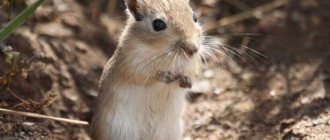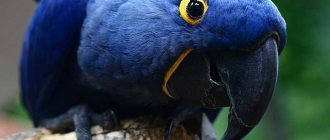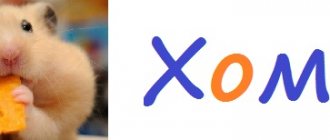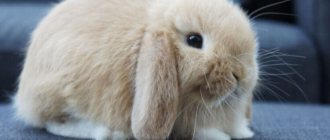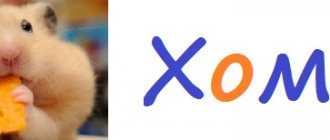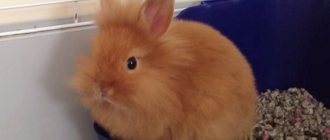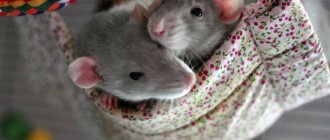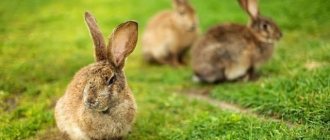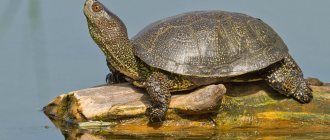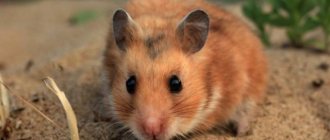Review author: “ZooVita”
A domestic decorative rabbit is a kind and sweet animal that can give a person joy and cheer him up. They are friendly and do not require special attention. They are easy to care for if you have at least the slightest idea about the chosen breed and the rules of maintenance.
Photos of decorative rabbits are touching. They look attractive and attractive: you definitely want to pick them up and caress them. Therefore, children have a special interest in them. The child is drawn to a homemade living “toy”, and the rabbit himself is not against such communication.
In order for your pet to be healthy and delight your family with its presence longer, you need to know some rules of care and maintenance.
Features of decorative rabbits
The purpose is in the name itself. They are not raised for fur or meat. People need them as a pet that requires care.
Most often, rabbits are taken for the sake of children, in order to instill in them a sense of responsibility, love and kindness. It’s impossible not to pay attention to a fluffy ball in a pet store!
The rabbit has many advantages:
- characterized by calm behavior;
- unlike cats, it is less active;
- unlike dogs, it is not capable of making loud sounds or making noise.
Breed varieties, color
In terms of external and qualitative characteristics, the varieties of the lop-eared sheep breed are very different:
- Meissen is a rare breed found in Germany;
- French - has become widespread in all countries;
- English - the owner of tiny front paws and large ears;
- plush - a rabbit with short, thick and soft hair;
- fleecy - distinguished by long hair;
- Dwarf and Dutch are the smallest breeds that live primarily in domestic conditions.
Valuable “coat”, high quality meat and attractive appearance are characteristic of all these breeds. The coat of animals is characterized by a wide variety. Plain white, black, gray, brown coat tones are often diluted with spots of a different color or tan marks.
Difference between decorative and dwarf rabbit
Buyers often confuse these two concepts. Any pet, regardless of its size, kept in the house can be called decorative. This is a pet.
Dwarf species include fluffies, whose size is small. They can also take the place of a family pet.
Taming Ability
Decorative rabbits are well socialized, but it will take time to adapt. You need to tame your pet immediately after it gets used to the new place a little. The process of getting used to household members lasts from 7 days to 3-4 months, it depends on the character and age of the rodent. Baby rabbits adapt faster, while adults are characterized by greater caution and timidity.
From the first days of being in the house, a decorative rabbit should be called by name. It is better to address him in a gentle and quiet voice so as not to scare him. The owner's movements should be smooth. As soon as your pet gets used to the voice and stops being afraid, you can move on to familiarizing yourself with your hands. This will also take time.
First, it is better to let your fingers and palms smell through the cage and treat the baby rabbit with a treat. When the animal is no longer afraid of hands, you can open the door and gently stroke it. It is important to do this daily until the pet begins to trust its owner.
After this, you can release the animal for a walk outside its home. For the first time, the cage is left open, and the owner must sit nearby and not make sudden movements. Curiosity will certainly force the little rabbit to come out of hiding and look around. The rodent should be rewarded with a piece of treat for its courage. The pet must return to the cage on its own.
Attention! While walking around the apartment, you need to keep an eye on the decorative rabbit. If he is left unattended, he may fall from a height, chew wires or furniture.
Types of decorative rabbits
There are many decorative types, which for the sake of order and systematization are distinguished by:
- sizes;
- coloring;
- fur length.
Origin story
The characteristic external features of lop-eared rabbits attract many breeders. Slightly enlarged head cartilages and ears turned inward by the pinna give them some resemblance to rams. Fold-eared sheep were mentioned in his works by Charles Darwin, who more than once encountered unique species of plants and animals in his travels.
In the 18th century, when crossing rabbits of the dwarf breed and French lop-eared rabbits, dwarf lop-eared ram rabbits were born. In 1950, Dutch breeders developed the first dwarf breeds. The world learned about a new interesting breed of rabbits 2 years later, after which the rapid conquest of lop-eared lambs in European countries began.
Only in 1997 did this breed become known in Russia. The first nurseries of this breed were just beginning to appear in large Russian cities. In Europe and the USA during these years, fold-eared rams were already bred with all their might.
Breeders encountered some difficulties at the beginning of their experiments. The ears of a small dwarf ram do not differ in massiveness and length. For this reason, these individuals had them standing upright rather than hanging.
Painstaking work and thorough research helped achieve the desired result. As soon as the age of the dwarf rabbit approaches 12 weeks, the ears that stubbornly stick out to the sides and upwards begin to lie along the head.
Sometimes this can happen in one ear first, and then in the other a few days later. During this period, pets look a little comical, resembling naughty pranksters in appearance.
Breeds of decorative rabbits
There are many types and breeds of decorative rabbits: 200 are known today. Moreover, selection continues! The most common and popular decorative fluffies include:
Fold-eared decorative rabbits
This species includes the Dutch breed and the dwarf ram. A distinctive feature is drooping ears, although the born “babies” have protruding ones.
Decorative rabbit of the Gremlin breed
Small sizes. Color – white. Eye color – gray. An animal with short legs, a round, slightly flattened face, and erect straight ears. Gremlin can be called a long-liver. With proper care it can live 10-12 years.
Decorative Rex rabbit
The breed is friendly with a gentle character. Has a dark brown color. An animal with a short tail and paws, with a round graceful face and protruding, short ears.
Decorative rabbit of the Pygmy breed
These are small rabbits that prefer warmth. They jump very little because their legs are too short. They live no more than 5 years.
It is impossible to list all breeds in one article. There are a lot of them: fox, lion, butterfly, squirrel, hare and others.
Pricing by breed
- A dwarf Rex without documents will cost 800 rubles, with a passport 1000-3000. A pet-class animal from a nursery costs 3000-3500 rubles, a breed-class animal 3500-4000, and an exhibition one 4000-6000.
- A lop-eared dwarf ram for home keeping costs 2700-4000 rubles, for breeding 4000-5000, show class 5000 and above. You can buy from 1000 from your own hands without papers. Vaccinated ones, with a passport, but not found through a nursery cost from 1000 to 3000.
- A dwarf hare without documents costs 1000-1500 rubles; pet class 2000-3000, breed 3000-4000, elite from 4500.
- Dutch dwarf on the market without papers from 1000 rubles, with documents 2000-3000, pet class 4000-6000, breed class 6000-8000, intended for shows from 8000 rubles.
- A dwarf butterfly on the market or secondhand will cost 500-1000 rubles; pet class 1500-2000, breed class 3000-4500, show class -5000-6000.
- Angora dwarf on the market costs 800-2500, pet class 2000-3000, breed class 3000-6000, show class from 6000 rubles.
- A dwarf moth purchased secondhand will cost 700-1500. A rabbit for the soul from a nursery costs 2000-2500, for breeding 2500-4000 rubles, for showing from 4000.
- A lion's head from the market without documents will cost 1000-1500, a vaccinated animal with papers costs 1500-3000. Pet 3000-3500, breed 3500-4000, show 4000-5500 rubles.
- A colored dwarf from the market costs 1200-1800, pet class 2000-3000, breed class 3000-4000, show class from 4000.
- A dwarf hermelin purchased on the market or by advertisement will cost 800-1500 rubles, a vaccinated baby from a nursery for the home will cost 2000-3000, for breeding 3000-4000, for exhibitions from 4500.
Fox Ram
The breed differs from the dwarf ram in its long fur, which reaches 5.5 cm in length and hangs almost to the floor.
The guard hairs are strong and thick, so they do not fall off, like in Angora rabbits. However, the coat requires care. The breed got its name because of its resemblance to foxes. The color can be red, agouti, chinchilla, white. The fox ram is characterized by small, erect ears covered with hair.
Cost from 2 thousand rubles and above.
Lion head
The breed was developed by crossing short-haired and long-haired individuals. The lion's head has not received recognition throughout the world, but in Russia it is widespread.
Rabbits have a compact body, developed limbs, a rounded head with vertical ears 7-8 cm long. On the neck and back of the head there is longer hair, the so-called mane.
Rabbits of this breed have an affectionate and playful disposition, but are quite timid. Once experiencing stress, they can show aggression towards the offender.
You should not have a pet if there are very young children in the house.
The price starts from 2.5 thousand rubles.
Feeding a decorative rabbit
The question of what to feed a decorative rabbit interests many rabbit breeders.
Feeding methods at home
There are classic feeding options or natural and artificial, using concentrated additives and feed.
The classic may not be suitable for everyone, as it is a troublesome option. The animal is fed:
- harvested grass;
- hay;
- greens;
- tree branches;
- leaves;
- mineral or salt stones.
For information! The rabbit needs to grind down its teeth, so bark is ideal for such purposes.
The second approach involves the use of mixed feed. By including concentrated supplements and feed in your animal’s diet, you don’t have to store hay for the winter.
This option greatly facilitates care and maintenance, but it is worth remembering about the health of your pet. It is unknown how such nutrition will affect the fragile body of a dwarf animal. Is it worth the risk?
Treats for decorative rabbits (list)
Suitable succulent food for rabbits:
- cabbage;
- carrot;
- Bulgarian pepper;
- beet;
- tomatoes;
- potato;
- other vegetables.
“Vegetable” lunch is served in the morning and at noon. It is advisable to alternate products. You should not feed cabbage frequently to avoid causing excessive gas or bloating.
The greens are slightly dried before serving. You can combine it with vegetables. Lettuce, parsley, celery are suitable for rabbits.
Need to know! Fruits, like berries, are considered a delicacy, so you shouldn’t pamper your fluffy with them often. Preference is given to apples, pears, and grapes.
Feeding
The rabbit's diet should be nutritious, complete and varied:
- Among vegetables, the ram prefers potatoes, broccoli, carrots; you should not feed him potato tops, tomatoes, beets, white cabbage and cauliflower;
- slightly dried and fresh meadow grass, dandelion, nettle will be a good source of vitamins in the summer;
- oats and wheat are suitable for grain crops;
- In winter, a fold-eared ram will like an armful of dry, fragrant herbs.
For rabbits, the main food is hay and nutritious grain mixtures. Before 6 months of age, you should not treat your baby to raw vegetables and fresh herbs, because the delicate digestive tract is not yet ready to absorb fiber and coarse fibers.
A grown rabbit can be given vegetables, fruits and green grass daily in small quantities. There should always be hay in the cage - a source of vital substances for the rabbit.
Oats, wheat, and crackers can be given as solid food, but in very moderate quantities. Rabbits should not be given dairy or meat products. Pets can sometimes be given milk for up to 2.5 months. There should always be standing, clean water in the cage. A mineral stone sold in pet stores should be attached to the wall of the cage.
Prohibited products for decorative rabbits
You should refuse:
- exotic fruits;
- bakery and dairy products;
- canned vegetables;
- Sahara;
- confectionery products;
- boiled or fried foods.
Important! The rabbit is unpretentious to food. He will be happy with everything that is given to him. He will not refuse food that is harmful to him, and will eat it with pleasure. Therefore, all responsibility for the life and health of the pet lies with the owner.
Breeding
Breeding dwarf fold rabbits is not difficult. Starting from 6 months of age, rabbits can reproduce safely. Fold rams are not particularly fertile. The female carries the rabbits for 28-36 days. With proper care, female rabbits can produce 6-7 rabbits in one litter.
A pregnant rabbit needs to be provided with maximum care. You need to keep the cage clean and give the animal more protein-rich, nutritious food.
Fresh, clean water is important for the female; it is recommended to give low-fat homemade cottage cheese and a hard-boiled egg once a day. In order for a mother rabbit to feed her babies for a long time, you need to disturb the animal as little as possible.
Sterilization and castration
At the onset of puberty, the ram rabbit begins to mark its territory and becomes restless and restless. Games with children are no longer interesting for the eared boy.
For females, the solution to the problem is sterilization, and for males, castration. After the operation, the ram becomes peaceful and calm. He is sleeping well, is interested in play again, and has a healthy appetite.
Starting from 4 months of age, females can be sterilized, but, according to many veterinarians, it is better to postpone the operation until 6 months of age, when the animal’s body becomes stronger and more mature and recovers faster after surgery.
The best age for castration of a male is 3.5-5 months. Experts do not give a definite answer as to whether it is possible to operate on individuals who have reached the age of 1-3 years. Most are inclined to believe that the operation is much more difficult for pets in this case. Before carrying out it, you must pass all the necessary tests and check the condition of the internal organs.
Rules for keeping a decorative rabbit at home
In order for an animal to feel comfortable in an apartment or house, it is necessary to take care of its place of “residence” in advance. For this purpose, a spacious cage is selected, which can be zoned into separate areas:
- for rest and sleep;
- for wakefulness;
- eating area, where a bowl for water and food is placed;
- toilet, where a special tray is placed.
Care and maintenance
By nature, fold-eared dwarf baby rams are rodents, so it is not at all surprising that they constantly need to chew something.
Rabbits will mercilessly tear apart wires that are not removed to a safe distance in the house. Eared pets can receive an electric shock at any time.
The permanent “place of residence” of a dwarf lop-eared ram will be a cozy, spacious cage that meets the following requirements:
- Dimensions no less than 0.7x0.5 meters.
- It is advisable to arrange a “house” in the cage - a safe shelter for your pet, in which he will feel completely protected.
- The location of the cage should be selected very carefully. It should be ventilated, but without cold drafts, well lit.
- Dwarf rams are quite clean by nature, so they will choose a corner for the toilet, in which you need to place a tray. Designed for cats is quite suitable for this purpose. You can use a special triangular corner tray.
- To prevent your pet from throwing cups in different directions and clinging to them with his paws, it is better to attach a drinking bowl with water to the wall of the cage, and use heavy ceramic dishes for the feeder. Moreover, no matter how much he wants, the baby will not be able to chew on it.
- It is advisable to let the rabbit out of the cage at least once a day for several hours so that it can stretch its legs.
- Use a special nail clipper to remove sharp claws so that the furniture in the house is not scratched.
The cleanliness of the feeders must be constantly monitored and the availability of clean water must be constantly taken care of. Animals eat frequently; the work of their gastrointestinal tract is based on pushing food through the arrival of new portions.
Pets can eat and defecate at the same time. For convenience, a feeder with hay is placed next to the tray. Well-dried wood shavings or finely shredded newsprint without printing ink are the best bedding materials.
Folds take care of the condition of their fur themselves, so they are bathed very rarely. The main thing is not to forget to clean their cage regularly and provide the animal with a clean tray every day. A ram demanding cleanliness will not go into a dirty litter box.
Cage for decorative rabbits (types)
Keeping decorative rabbits in apartments requires the presence of a separate area for establishing a “house” (cage). This can be any space or place. The compact version can easily fit on a dresser, bedside table or table.
When choosing, you need to pay attention to:
- dimensions and shape;
- the material from which it is made. You need to avoid wood, as your pet can chew it off;
- lack of paint on the rods - there should be no paint or varnish, since the rabbit will definitely “taste” them;
- presence of a removable tray. It is desirable that it be made of plastic;
- surface smoothness. Any protruding parts or hangnails can injure your pet.
What does the price depend on?
The price of these pets varies greatly. The cost of a rabbit is affected by:
- his breed;
- presence of pedigree;
- place of purchase;
- breeding quality;
- conditions of detention;
- pet health.
Because of this, a pet can cost from 500 rubles to tens of thousands . To understand how much a decorative rabbit costs, you need to study the points in more detail.
There is nothing to say about the breed, because it is clear that a purebred animal is more expensive. Much more interesting is the presence of a pedigree.
In the case of buying a rabbit for the home, the pedigree can be neglected, since it greatly increases the price, but at the same time it makes sense only for those who buy it for exhibition or breeding.
Raising a rabbit with a good pedigree is expensive, because you need to select suitable pairs and maintain them. Several generations of properly selected families must pass before he becomes the owner of a pure pedigree. Because of this, the price of a pet can reach tens of thousands of rubles.
Pedigree is confirmed by special documents! When purchasing an animal with a pedigree, you should especially carefully read the document confirming its presence.
Breeding quality is divided into three types: pet , breed , show class . The first is intended for home keeping, the second for breeding, and the third for exhibitions. The latter are the most expensive.
Rabbits whose maintenance requires special conditions will cost more because of this. Often they can be inexpensive due to the fact that the seller does not take their maintenance seriously, which can negatively affect the health of the pets.
By the way, about health. When choosing, you should pay special attention to this. If the ears are not symmetrical, the back is concave or too rounded, there are ulcers on the paws, the anus has redness or signs of diarrhea, the rabbit itself looks stunted, you should refuse the purchase, otherwise you will have to spend a lot of money on veterinary services and medications for your pet.
What is needed in a cage for a decorative rabbit
The cage must contain several mandatory positions, without which the decorative rabbit will not be comfortable or calm.
- Since rabbits prefer closed spaces (burrows), the presence of a secluded place hidden from prying eyes is mandatory.
- A drinking bowl will need to be installed. Water must be available at all times.
- Bark for growing teeth and grinding them down.
- Bowl for food.
- Toilet tray.
Diseases
Decorative rabbits can suffer from infectious and viral diseases. The main ones are rhinitis, stomatitis, staphylococcosis, otitis, conjunctivitis. The animals suffer from intestinal disorders, and the active growth of teeth causes them severe inconvenience. A complete list of diseases of decorative rabbits is presented in this material.
It is recommended that decorative rabbits receive vaccinations - and, believe me, they will cost you much less than further treatment.
Competent care and proper feeding will help to avoid diseases. Make sure that the animal’s diet is balanced, otherwise constant diarrhea cannot be avoided.
Stomach upset is caused by weevil-infected dry food, excess fruits and vegetables, moldy bread, sudden changes in feed, gastrointestinal diseases, unsanitary conditions, and viruses. A common occurrence is constipation. Read what to do if your rabbit is constipated here.
In case of diarrhea, you need to disinfect the cage and give the animal a decoction of chamomile. If it doesn't go away for a long time, contact your veterinarian.
It is necessary to monitor the health of rabbits by regularly conducting veterinary examinations.
